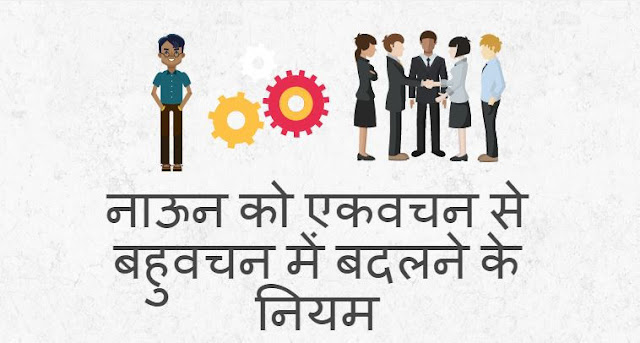नाऊन को एकवचन से बहुवचन में बदलने के नियम – Rules to Change Singular Nouns Into Plural nouns

Contents
- 1 नाऊन को एकवचन से बहुवचन में बदलने के नियम – Rules to Change Singular Nouns Into Plural nouns
- 1.1 Rules for Changing Singular Nouns into Plural Nouns
- 1.2 1. Add “S” to Most Singular Nouns
- 1.3 2. Add “ES” to Nouns Ending in S, SH, CH, X, or Z
- 1.4 3. Change “Y” to “IES” if Preceded by a Consonant
- 1.5 4. Change “F” or “FE” to “VES”
- 1.6 5. Irregular Plural Nouns (No Fixed Rule)
- 1.7 6. Nouns That Stay the Same in Singular and Plural
- 1.8 7. Plural of Compound Nouns
- 1.9 8. Foreign Words with Unique Plurals
- 1.10 Summary of Pluralization Rules
नाऊन को एकवचन से बहुवचन में बदलने के नियम – Rules to Change Singular Nouns Into Plural nouns
- कुछ Singular Nouns के अंत में S जोडकर उन्हें Plural बनाया जाता है
- जैसे – Books, Hens, Dogs
- कुछ Singular Nouns जिनके अंत में x, ch, ss,sh,s,o,z आता हो तो ऐसे Singular Nouns के अंत में es जोडकर उन्हें Plural बनाया जाता है
- जैसे – Foxes, Heroes, Texes
- कुछ Singular Nouns के अंत में ch से हो परन्तु उनका उच्चारण क (K) की तरह हो तो एेेसे Singular Nouns के अतं में s जोडकर Plural बनाया जाता है
- जैसे – Conch, Monarch,
- जिस Nouns के अंत मेंं f या fe हो तो f या fe को v में बदलकर उसमें es जोड कर Plural बनाया जाता है
- जैसे – (Wolf-Wolves) (Leaf-Leaves)
- लेकिन कुछ Nouns में यह नियम लागू नहीं होता है
- जैसे – (roof-roofs) (gulf-gulfs) (reef- reefs)
- जिस Nouns के अंत में y हो और y के पहले कोई consonant हो तो y को ies में बदलकर Plural बनाया जाता है
- जैसे – (Duty-Duties) (fly-flies) (army-armies)
- जिन Nouns के अंत में y के पहले कोई vowel हो तो उसमें सिर्फ s जोडकर Plural बनाया जाता है
- जैसे – (Key-Keys) (Play-Plays) (Valley-Valleys)
- Compound Noun का Plural उनके Principal/Main शब्द को Plural बनाकर किया जाता है
- जैसे – (Sister-in-low – Sisters-in-low), (Chief-minister – Chief-ministers)
- लेकिन ऐसेे Compound Noun जो Man तथा Woman से बने हों तो दोनों Parts को Plural बनाया जाता हैै
- जैसे – (Man-teacher – Men teachers), (Woman-servant – Women-servants)
Rules for Changing Singular Nouns into Plural Nouns
Plural nouns refer to more than one person, place, or thing. There are different rules for forming plural nouns based on the ending of the singular noun.
1. Add “S” to Most Singular Nouns
Rule: For most nouns, simply add “-s” to make them plural.
Examples:
-
Car → Cars
-
Book → Books
-
Dog → Dogs
-
Pen → Pens
2. Add “ES” to Nouns Ending in S, SH, CH, X, or Z
Rule: If a noun ends in -s, -sh, -ch, -x, or -z, add “-es” to form the plural.
Examples:
-
Bus → Buses
-
Brush → Brushes
-
Bench → Benches
-
Box → Boxes
-
Quiz → Quizzes (Double the “z” before adding “-es”)
3. Change “Y” to “IES” if Preceded by a Consonant
Rule: If a noun ends in “-y” and there is a consonant before it, change “-y” to “-ies”.
Examples:
-
City → Cities
-
Baby → Babies
-
Story → Stories
-
Lady → Ladies
Exception: If a vowel (a, e, i, o, u) comes before “-y”, just add “-s”.
Examples:
-
Toy → Toys
-
Day → Days
-
Key → Keys
4. Change “F” or “FE” to “VES”
Rule: If a noun ends in “-f” or “-fe”, change it to “-ves”.
Examples:
-
Knife → Knives
-
Wolf → Wolves
-
Leaf → Leaves
-
Life → Lives
Exception: Some words just add “-s” instead of changing “f” to “ves.”
Examples:
-
Roof → Roofs
-
Belief → Beliefs
-
Cliff → Cliffs
5. Irregular Plural Nouns (No Fixed Rule)
Rule: Some words completely change their spelling in plural form.
Examples:
-
Man → Men
-
Woman → Women
-
Child → Children
-
Tooth → Teeth
-
Foot → Feet
-
Mouse → Mice
-
Goose → Geese
6. Nouns That Stay the Same in Singular and Plural
Rule: Some nouns do not change in their plural form.
Examples:
-
Deer → Deer
-
Sheep → Sheep
-
Fish → Fish (Some say “Fishes” when referring to different species.)
-
Aircraft → Aircraft
7. Plural of Compound Nouns
Rule: In compound nouns, pluralization depends on the structure.
If the noun part changes:
-
Brother-in-law → Brothers-in-law
-
Passer-by → Passers-by
If the word is a single unit, add “-s” to the end:
-
Cupboard → Cupboards
-
Pickpocket → Pickpockets
8. Foreign Words with Unique Plurals
Rule: Some words borrowed from other languages have unique plurals.
Examples:
-
Cactus → Cacti
-
Datum → Data
-
Radius → Radii
-
Alumnus → Alumni
-
Analysis → Analyses
Summary of Pluralization Rules
| Singular Ending | Plural Rule | Example |
|---|---|---|
| Most nouns | Add “-s” | Dog → Dogs |
| -s, -sh, -ch, -x, -z | Add “-es” | Box → Boxes |
| -y (after consonant) | Change “-y” to “-ies” | Baby → Babies |
| -y (after vowel) | Just add “-s” | Toy → Toys |
| -f or -fe | Change “-f/-fe” to “-ves” | Wolf → Wolves |
| Irregular nouns | Change completely | Man → Men |
| Unchanging nouns | No change | Deer → Deer |
| Compound nouns | Change the noun part | Brother-in-law → Brothers-in-law |
Would you like more examples?
